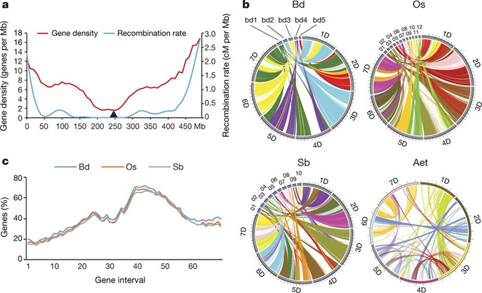小麦野生远祖基因组测序完成
来源:《自然》
作者:Jan Dvorak等
时间:2017-11-29


11月15日出版的《自然》杂志刊登了一篇研究论文称,美国加州大学戴维斯分校科学家领导的国际团队,成功为小麦的一种野生远祖——节节麦(Aegilops tauschii)进行了基因组测序,向破解小麦基因组难题迈进了一步。
作为全球主要粮食作物,小麦为人类提供了超过20%碳水化合物和23%蛋白质等营养需求,但因其基因组规模庞大且复杂,20年来,科学家们一直没能完成小麦全基因组的测序任务。小麦及其野生远祖的基因数量为人类的6倍,含有的碱基数有17兆之多,且小麦基因组是六倍体,这意味着它由3套不同的基因组组成,所有这些特点使得为小麦进行基因组测序变得非常困难。
这次破解的节节麦也是如此。节节麦也叫山羊草,是一种生长在荒芜草地或麦田中的野生小麦,具有对极端环境的高适应能力以及耐病特性。但其基因组一样具有规模过大和复杂等特点,其84%基因组由重复序列构成。加州大学戴维斯分校植物学教授简·德沃夏克的团队结合多种先进测序技术,最终获得具有参考价值的节节麦基因组序列,将为改良小麦品种、提高小麦面粉质量提供主要的基因来源。
德沃夏克表示,他们的新成果已经收获实效——利用节节麦中发现的两种抗小麦秆锈病基因,培育出了全新的小麦品种。未来,研究人员可以根据节节麦的基因组序列,找到改善小麦烘焙质量、抗病性以及对寒冷、干旱、高盐等极端环境条件忍耐力的新基因。(来源:科技日报 聂翠蓉)
Abstract Aegilops tauschii is the diploid progenitor of the D genome of hexaploid wheat1 (Triticum aestivum, genomes AABBDD) and an important genetic resource for wheat2–4. The large size and highly repetitive nature of the Ae. tauschii genome has until now precluded the development of a reference-quality genome sequence5. Here we use an array of advanced technologies, including orderedclone genome sequencing, whole-genome shotgun sequencing, and BioNano optical genome mapping, to generate a referencequality genome sequence for Ae. tauschii ssp. strangulata accession AL8/78, which is closely related to the wheat D genome. We show that compared to other sequenced plant genomes, including a much larger conifer genome, the Ae. tauschii genome contains unprecedented amounts of very similar repeated sequences. Our genome comparisons reveal that the Ae. tauschii genome has a greater number of dispersed duplicated genes than other sequenced genomes and its chromosomes have been structurally evolving an order of magnitude faster than those of other grass genomes. The decay of colinearity with other grass genomes correlates with recombination rates along chromosomes. We propose that the vast amounts of very similar repeated sequences cause frequent errors in recombination and lead to gene duplications and structural chromosome changes that drive fast genome evolution.
原文链接:http://www.nature.com/articles/nature24486.pdf




